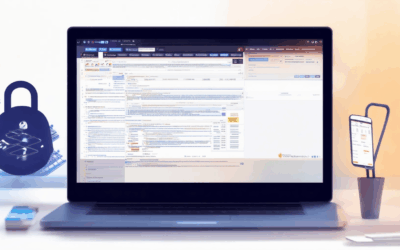In today’s digital landscape, safeguarding sensitive information has become paramount. As businesses and organizations handle increasingly complex data, the need for robust data protection strategies has never been more critical. Whether it’s protecting customer data, intellectual property, or personal records, failing to implement effective strategies can lead to devastating consequences, including financial losses, reputational damage, and legal penalties. With cyber threats evolving rapidly, staying ahead of potential breaches requires a proactive approach to data security.
Key Takeaways
– Encryption: Protect sensitive data with robust encryption methods like AES-256 to ensure confidentiality during transmission and storage.
– Access Control: Implement multi-factor authentication (MFA) and role-based access control (RBAC) to restrict access and minimize unauthorized risks.
– Data Minimization: Adopt a minimalist approach by collecting only essential data to reduce exposure risks and improve security.
– Regular Audits: Conduct thorough security audits to uncover vulnerabilities and ensure compliance with regulations like GDPR or CCPA.
– Incident Response Plan: Prepare and regularly test an incident response plan to address breaches swiftly and mitigate damage.
– Third-Party Management: Carefully vet vendors and enforce data protection standards to safeguard sensitive information.
– Employee Training: Provide ongoing cybersecurity training to enhance awareness and reduce human error-related risks.
– Monitoring and Logging: Continuously monitor activities and maintain logs to detect and respond to suspicious actions promptly.
– Compliance: Stay informed about data protection laws and ensure adherence to legal standards to avoid penalties and protect privacy.
– Disaster Recovery: Develop and test backup systems to ensure quick data restoration in case of loss or theft.

Best Data Protection Strategies
To ensure sensitive information remains secure, implement the following comprehensive strategies:
- Encryption : Protect data through encryption algorithms like AES (Advanced Encryption Standard) and SSL/TLS (Secure Sockets Layer/Transport Layer Security). Use strong, unique passwords for all accounts and regularly update them.
- Access Control : Restrict access to sensitive data to only authorized individuals. Implement multi-factor authentication (MFA) and role-based access controls (RBAC) to minimize exposure risks.
- Regular Backups : Create and store encrypted backups of critical data offsite, such as in secure cloud storage or external drives. Test backups periodically to ensure recovery feasibility.
- Software Updates : Keep all systems, applications, and software up-to-date with the latest patches and security enhancements. Enable automatic updates whenever possible.
- Employee Training : Conduct regular cybersecurity awareness training for all staff members to educate them on best practices and potential threats like phishing attacks.
- Monitoring and Logging : Continuously monitor network traffic and system activities for suspicious behavior. Maintain logs of all access attempts and changes made to data or systems.
- Physical Security : Secure physical locations where sensitive data is stored, such as servers and document storage areas, using access controls and surveillance systems.
By combining these strategies, organizations can significantly reduce the risk of data breaches and ensure the confidentiality, integrity, and availability of their sensitive information.
Essential Data Protection Strategies to Safeguard Sensitive Information
Protecting sensitive information is crucial in today’s digital age. Here are the top strategies to ensure your data remains secure:
- 1. Implement Strong Encryption:** Use encryption to protect data at rest and in transit. This includes encrypting files, databases, and communications.
- 2. Enforce Access Controls:** Limit access to sensitive information to only those who need it. Use multi-factor authentication and role-based access to minimize risks.
- 3. Regularly Audit and Update Systems:** Conduct frequent security audits to identify vulnerabilities. Keep software, hardware, and applications updated to patch security gaps.
- 4. Train Employees:** Educate your workforce on data protection best practices to reduce human error-related breaches.
- 5. Use Data Anonymization and Pseudonymization:** Mask sensitive information so it can’t be traced back to individuals, even in aggregated form.
- 6. Implement Data Backup and Recovery Plans:** Regularly backup important data and store it securely offsite. Have a plan in place to restore data in case of loss.
- 7. Monitor and Log Activity:** Continuously monitor systems for suspicious activity and maintain logs to aid in incident response and forensic analysis.
- 8. Collaborate with Security Experts:** Partner with professionals to conduct threat assessments and implement advanced security measures tailored to your organization.
- 9. Stay Updated on Threat Trends:** Keep abreast of the latest cyber threats and adapt your defenses accordingly to stay ahead of potential attackers.
- 10. Consider Third-Party Tools:** Utilize specialized tools and services, such as BlindBrowser , which offer additional layers of security for online activities.
By combining these strategies, you can significantly reduce the risk of data breaches and ensure that sensitive information remains protected.

The Best Data Protection Strategies to Safeguard Sensitive Information
Protecting sensitive information is crucial in today’s digital age. Here are the most effective strategies to ensure your data remains secure:
- Encryption: Use strong encryption algorithms to safeguard data at rest and in transit. Implement HTTPS for web traffic and encrypt sensitive files stored on servers or devices.
- Access Control: Limit access to sensitive information to only authorized individuals. Use multi-factor authentication (MFA) and role-based access controls (RBAC) to minimize exposure risks.
- Regular Audits and Vulnerability Assessments: Conduct frequent security audits to identify and fix vulnerabilities. Stay updated with the latest cybersecurity threats and adapt your defenses accordingly.
- Data Minimization: Collect only the necessary data and anonymize information wherever possible. This reduces the risk of data breaches and unauthorized access.
- Incident Response Plan: Develop a comprehensive plan to respond to data breaches. Regularly test and update your response procedures to ensure quick and effective resolution.
- Training and Awareness: Educate employees and stakeholders about data protection best practices. Regular security awareness programs can significantly reduce human error-related incidents.
- Third-Party Management: If outsourcing functions, ensure third-party vendors comply with strict data protection agreements. Regularly audit their security measures to maintain trust.
- Log and Monitoring Systems: Implement robust logging and monitoring solutions to track data access and unusual activities. Use these logs to investigate potential security incidents promptly.
- Physical Security Measures: Protect physical assets such as servers and storage devices with advanced security protocols. Consider biometric authentication and secure physical access controls.
By combining these strategies, organizations can significantly enhance their ability to protect sensitive information and maintain compliance with relevant regulations. Remember to regularly review and update your security measures to keep pace with evolving threats and technologies.

Key Data Protection Strategies to Safeguard Sensitive Information
Protecting sensitive information is crucial in today’s digital age. Here are the top strategies to ensure your data remains secure:
- 1. Encryption
- Encrypt all sensitive data, including files, communications, and databases, using advanced algorithms like AES and SSL/TLS.
- Ensure encryption keys and passwords are stored securely and regularly backed up.
- 2. Access Control
- Implement multi-factor authentication (MFA) to restrict access to sensitive systems and data.
- Use role-based access control (RBAC) to limit access to only authorized personnel.
- Regularly review and update user permissions to minimize unauthorized access risks.
- 3. Data Minimization
- Collect only the minimum amount of personal data necessary for a specific purpose.
- Analyze and delete unnecessary data periodically to reduce exposure risks.
- 4. Regular Audits
- Conduct frequent security audits to identify vulnerabilities and ensure compliance with regulations.
- Use automated tools to scan for misconfigured settings or outdated software.
- Perform manual reviews of sensitive data storage and access patterns.
- 5. Incident Response Plan
- Develop and regularly test an incident response plan to address data breaches swiftly.
- Establish communication protocols for notifying stakeholders during incidents.
- Minimize downtime by having backup systems in place.
- 6. Third-Party Management
- Vet third-party vendors thoroughly before sharing sensitive data.
- Include data sharing agreements in contracts and monitor compliance.
- Limit data disclosure to only what is necessary for service delivery.
- 7. Employee Training
- Provide regular cybersecurity training to all employees, focusing on awareness and best practices.
- Test knowledge retention through quizzes and simulations.
- Encourage a culture of security by recognizing and rewarding compliant behavior.
- 8. Monitoring and Logging
- Implement continuous monitoring systems to detect suspicious activities in real-time.
- Log all access attempts, changes, and errors for forensic analysis.
- Use logs to identify potential security threats and investigate incidents proactively.
- 9. Compliance and Legal Requirements
- Stay updated on data protection laws and regulations applicable to your organization.
- Conduct regular compliance checks to ensure adherence to legal standards like GDPR, CCPA, and HIPAA.
- Document compliance measures and maintain records for audit purposes.
- 10. Disaster Recovery
- Develop and regularly test a robust disaster recovery plan to restore data quickly after an incident.
- Backup critical data frequently and store it in secure, off-site locations.
- Ensure backup systems are tested and functional in case of data loss.
By implementing these strategies, you can significantly reduce the risk of data breaches and ensure the confidentiality, integrity, and availability of your sensitive information. Remember to stay informed about emerging threats and adapt your strategies accordingly to maintain optimal data protection.
Data Protection Strategies for Safeguarding Sensitive Information

Data Protection Strategies: Safeguarding Sensitive Information
Protecting sensitive information is critical in today’s digital age. With increasing cyber threats and data breaches, organizations and individuals must implement robust data protection strategies to safeguard personal, financial, and proprietary data. Below are the most effective approaches to securing sensitive information:
- Encryption:** One of the most fundamental methods, encryption converts data into a coded format that can only be accessed with the correct decryption key. This ensures that even if unauthorized parties gain access to the data, they cannot read or use it effectively.
- Access Control:** Restricting who can access sensitive information is a cornerstone of data protection. Implement multi-factor authentication, role-based access, and physical security measures to limit exposure.
- Regular Backups:** Data breaches can happen at any time, so having regular, encrypted backups stored securely offsite is essential. This allows for quick recovery in case of loss or theft.
- Secure Remote Access:** When allowing remote access to systems or data, use VPNs, two-factor authentication, and encrypted communication channels to prevent unauthorized access.
- Data Anonymization:** Wherever possible, anonymize data before sharing or storing it. This reduces the risk of re-identification and protects individual privacy.
- Employee Training:** Human error is a leading cause of data breaches. Regularly educate employees on best practices, phishing awareness, and data handling procedures to minimize risks.
- Third-Party Vendors:** When working with external partners, ensure they adhere to strict data protection standards. Perform due diligence and establish clear contractual obligations regarding data security.
- Monitor and Audit:** Continuously monitor access logs, network traffic, and system activities. Conduct regular audits to identify vulnerabilities and ensure compliance with regulations like GDPR, HIPAA, or PCI-DSS.
By combining these strategies, organizations can significantly reduce the risk of data breaches and protect sensitive information effectively. Remember, proactive measures and continuous improvement are key to staying ahead of evolving threats.




